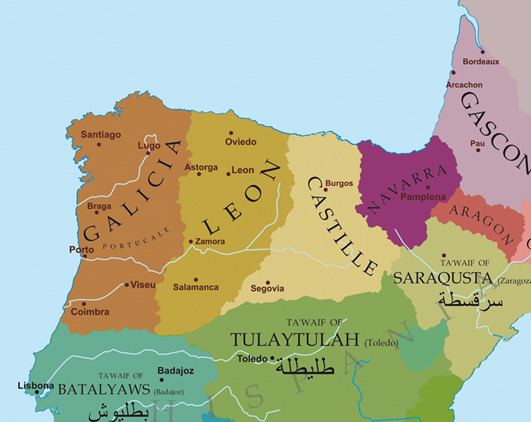Reign 1065–1072 Successor Alfonso VI | Predecessor Ferdinand I Reign 1072 Predecessor Alfonso VI | |
 | ||
Place of burial Monastery of San Salvador de Oña, Oña, Spain Siblings Alfonso VI of León and Castile, Urraca of Zamora Parents Ferdinand I of León, Sancha of León Similar | ||
Sancho II (1036/8 – 7 October 1072), called the Strong (el Fuerte), was King of Castile (1065–72), Galicia (1071–72) and León (1072).
Contents
Family
Born at Zamora, Sancho was the eldest son of Ferdinand the Great and Sancha of León. He was married to Alberta, a possible daughter of William I, king of England.
After Ferdinand the Great defeated and killed his wife's brother in battle, Ferdinand was crowned King of León and Castile and called himself Imperator totius Hispaniae ("Emperor of all Spain").
When the kingdom was divided following Ferdinand's death in 1065, Sancho succeeded his father as King of Castile, while Sancho's younger brother Alfonso become King of León and his youngest brother García became King of the reestablished Kingdom of Galicia (partitioned from León). Each of the brothers was also assigned a sphere of influence among the Taifa states.
Ferdinand also granted some holdings to his two daughters, giving Urraca control of the city of Zamora and Elvira the city of Toro, both enclaved within Alfonso's Kingdom of León.
Expansion and defeat
In 1068, Sancho defeated his cousins Sancho IV of Navarre and Sancho of Aragon in the War of the Three Sanchos. This expanded his Kingdom of Castile with the reconquered land of Bureba, Alta Rioja, and Álava, which his father had given to Sancho IV's father, García, for his support in defeating Bermudo III of León.
In 1068, Alfonso invaded the Taifa of Badajoz, a client state of brother Garcia's Kingdom of Galicia. Sancho, concerned that Alfonso had intentions on conquering his brothers, defeated Alfonso at the Battle of Llantada, reinstating the status quo.
Sancho would develop his own appetite for his youngest brother's kingdom. Teaming up with Alfonso in 1071, Sancho marched across León to conquer García's northern lands at the time that Alfonso was in the southern part of the Galician realm issuing charters. García fled to exile in Taifa of Seville, while his older brothers partitioned the Kingdom of Galacia between them.
Sancho soon turned on Alfonso. In 1072, with the aid of his alférez El Cid, he defeated Alfonso at the Battle of Golpejera, who fled into exile in the Taifa of Toledo. Sancho was crowned King of León on 12 January 1072, simultaneously holding all three crowns that Ferdinand had distributed to his sons only six years earlier.
Toro, the city of Sancho's sister Elvira, fell easily in 1072. But in a siege of sister Urraca's better-defended city of Zamora, Sancho was stalled. A Zamoran noble, Vellido Adolfo (also known as Bellido Dolfos), entered Sancho's camp pretending to be a deserter, seeking a private conference with Sancho to tell him the weaknesses in the Zamoran defence. Once before Sancho, Vellido assassinated him, using Sancho's own sword to impale him in the back. Vellido was chased back to Zamora by El Cid, but escaped into the town through a gateway since called Portillo del Traidor ("Gateway of the Traitor"). Sancho was succeeded in his kingdoms by the brother he had previously deposed, Alfonso. García, induced to return from exile, was imprisoned by Alfonso for life, leaving Alfonso in uncontested control of the reunited territories of their father, later taking on their father's title "Emperor of all Spain".
Sancho was buried in San Salvador de Oña.
